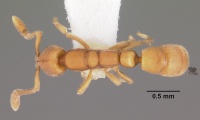Iroponera
| Iroponera | |
|---|---|

| |
| Iroponera odax | |
| Scientific classification | |
| Kingdom: | Animalia |
| Phylum: | Arthropoda |
| Class: | Insecta |
| Order: | Hymenoptera |
| Family: | Formicidae |
| Subfamily: | Ponerinae |
| Tribe: | Ponerini |
| Alliance: | Ponera genus group |
| Genus: | Iroponera Schmidt & Shattuck, 2014 |
| Type species | |
| Iroponera odax | |
| Diversity | |
| 1 species (Species Checklist, Species by Country) | |
Iroponera is a monotypic genus (Iroponera odax) restricted to south-eastern Australia. It occurs in wet forested habitats and is infrequently encountered.
| At a Glance | • Monotypic |
Identification
Schmidt and Shattuck (2014) - Iroponera workers are recognizable by the presence of a single metabial spur, absence of eye (although small dimples or slight discolorations are sometimes present where the eyes would be expected) and elongate and narrow mandibles with three or four small, widely spaced teeth. In overall body shape and size Iroponera closely resembles Hypoponera or Ponera, and all of these genera share the single metatibial spur. However, the unique mandibular shape and lack of eyes will separate this genus from others in the subfamily.
| See images of species within this genus |
Keys including this Genus
Distribution
Iroponera is restricted to south-eastern Australia (southern New South Wales, Victoria and Tasmania).
Distribution and Richness based on AntMaps
Species by Region
Number of species within biogeographic regions, along with the total number of species for each region.
| Afrotropical Region | Australasian Region | Indo-Australian Region | Malagasy Region | Nearctic Region | Neotropical Region | Oriental Region | Palaearctic Region | |
|---|---|---|---|---|---|---|---|---|
| Species | 0 | 1 | 0 | 0 | 0 | 0 | 0 | 0 |
| Total Species | 2851 | 1736 | 3047 | 932 | 840 | 4391 | 1767 | 2925 |
Biology
This genus has been encountered only a handful of times and very little is known regarding its biology. All collections have been made at wetter sites consisting of wet sclerophyll woodlands. Nests occur in soil under rocks or under bark and contain only a few workers. The lack of eyes, small body size and pale color suggest a hypogeic lifestyle, and this may explain their infrequent collection. (Schmidt and Shattuck 2014)
Castes
Known only from the worker caste.
Nomenclature
The following information is derived from Barry Bolton's Online Catalogue of the Ants of the World.
- IROPONERA [Ponerinae: Ponerini]
- Iroponera Schmidt & Shattuck, 2014: 196. Type-species: Iroponera odax, by original designation.
Unless otherwise noted the text for the remainder of this section is reported from the publication that includes the original description.
Description
Worker
Schmidt and Shattuck (2014) - Small-sized (TL 2.6 mm) ants with the standard characters of Ponerini. Mandibles elongate and narrow, with three or four small, widely spaced teeth on the masticatory margin, the basal margin essentially absent, and lacking a basal groove or pit. Anterior clypeal margin broadly rounded and convex. Frontal lobes moderately large. Antennae often with a four segmented apical club. Eyes essentially absent, at most with small dimples or slight discolorations present where the eyes would be expected. Metanotal groove reduced to a suture. Propodeum broad dorsally. Propodeal spiracles round to oval. Metatibial spur formula (1p). Petiole nodiform. Helcium projecting from near midheight of anterior face of A3. Prora reduced and apparently absent. Girdling constriction between pre- and postsclerites of A4 apparent. Head, mesosoma and petiole weakly sculptured and with a matte surface, gaster weakly punctate. Head and body with scattered pilosity and a moderately dense pubescence. Color orange.
Etymology
The name Iroponera is based on the Latin ironia, assumed ignorance, combined with the suffix -ponera, derived from the subfamily name Ponerinae. The name expresses our surprise at finding such a novel genus in a well-collected country like Australia.
References
- Esteves, F.A., Fisher, B.L. 2021. Corrieopone nouragues gen. nov., sp. nov., a new Ponerinae from French Guiana (Hymenoptera, Formicidae). ZooKeys 1074, 83–173 (doi:10.3897/zookeys.1074.75551).
- Schmidt, C.A. & Shattuck, S.O. 2014. The higher classification of the ant subfamily Ponerinae (Hymenoptera: Formicidae), with a review of ponerine ecology and behavior. Zootaxa 3817, 1–242 (doi:10.11646/zootaxa.3817.1.1).

